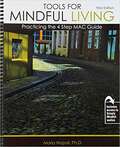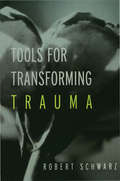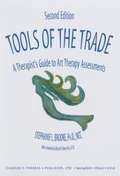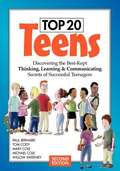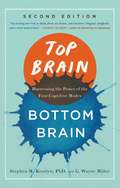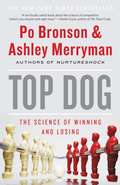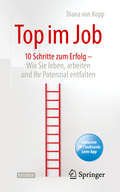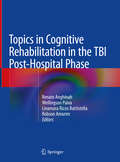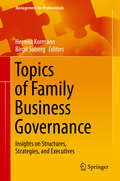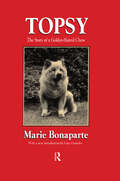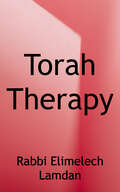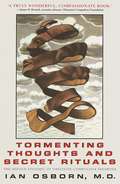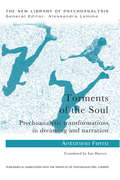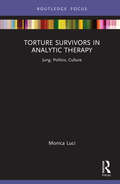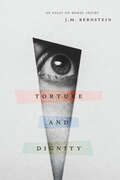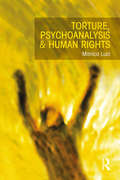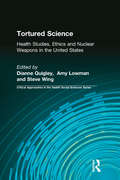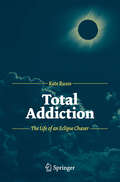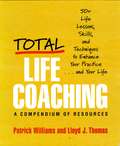- Table View
- List View
Tools for Mindful Living: Practicing the 4 Step MAC Guide
by Ph. D. Maria NapoliTools for Mindful Living: Practicing the 4 Step MAC Guide offers you an opportunity to understand mindfulness and identify markers on how stress impacts your life. <p><p> Each chapter offers the reader various opportunities to practice mindfulness using the simple and applicable 4 Step MAC Guide. Focusing on how one reacts or responds to their experiences and conscious attention to information communicated by one’s breath, senses, body, thoughts, emotions and instincts will be discussed throughout the book. <p><p> Discovering personal communication styles that impact every day occurrences and relationships will contribute to living mindfully. As you integrate mindfulness into your daily life, being present for all of your experiences without internal or external filters will become second nature. Get ready for a transformational ride!
Tools for Researching Vocabulary
by Paul Meara Imma MiralpeixThis book introduces an innovative collection of easy-to-use computer programs that have been developed to measure and model vocabulary knowledge. The book aims to help researchers discover new instruments for lexical analysis, and provides a theoretical framework in which studies with such tools could be conducted. Each of the programs comes with a short manual explaining how to use the program, an example of a published paper that uses the program and a set of questions that readers can develop into proper projects. The programs can be used in real research projects and have the potential to break new ground for research in L2 vocabulary acquisition. The book will be of great use to final year undergraduates and masters students in applied linguistics, second language acquisition, psycholinguistics and language testing and to PhD students doing research methods courses.
Tools for Transforming Trauma
by Robert SchwarzTools for Transforming Trauma provides clinicians with an integrative framework that covers a wide range of therapeutic modalities and a "black bag" full of therapeutic tools for healing trauma patients.
Tools of the Trade: A Therapist's Guide to Art Therapy Assessments (Second Edition)
by Stephanie L. BrookeThis new edition with its revised title provides critical reviews of art therapy tests along with some new reviews of assessments and updated research in the field. It is comprehensive in its approach to considering reliability and validity evidence provided by test authors. Additionally, it reviews research on art therapy assessments with a variety of patient populations. The book contains helpful suggestions regarding the application of art therapy assessments. Specific areas covered include individual, group, family, and multicultural assessment techniques. The desirable and undesirable features of a variety of art therapy assessments are deliberated. This book will be a valuable resource for practitioners who use art therapy as an adjunct or primary therapy, and it will serve to enhance clinical skills, making therapy more effective for each patient who participates in the assessment process. The book critiques a series of art therapy assessments-from traditional art therapy approaches to current releases. The goal of this work is to assist mental health professionals in selecting assessments that yield reliable and valid clinical information regarding their clients. Of special interest is the author's approach to writing the results of a series of art therapy assessments in an effort to provide a more complete indication of client dynamics and issues. It will be a valuable resource for practitioners who use art therapy as an adjunct or primary therapy, and it will serve to enhance clinical skills, making therapy more effective for each patient who participates in the assessment process.
Top 20 Teens: Discovering the Best-Kept Thinking, Learning and Communicating Secrets of Successful Teenagers (2nd Edition)
by Michael Cole Paul Bernabei Tom Cody Mary Cole Willow SweeneyApplication of the principles discussed in this book could result in you making a positive difference in your life and the lives of others! <p>All teens have the potential to become difference makers, to create meaningful and successful experiences for themselves and others However, not all teens know they have this power. That's where this book comes in. <p>Developed by a team of students, parents and educators, Top 20 Teens presents the Thinking, Learning and Communicating skills of the Top 20, the difference makers. By applying these skills in your personal relationships and school experiences, you can become the author of your life's story rather than just a character in it.
Top Brain, Bottom Brain: Surprising Insights into How You Think
by G. Wayne Miller Stephen KosslynOne of the world&’s leading neuroscientists teams up with an accomplished writer to debunk the popular left-brain/right-brain theory and offer an exciting new way of thinking about our minds.For the past fifty years, popular culture has led us to believe in the left-brain vs. right-brain theory of personality types. Right-brain people, we&’ve been told, are artistic, intuitive, and thoughtful, while left-brain people tend to be more analytical, logical, and objective. It would be an illuminating theory if it did not have one major drawback: It is simply not supported by science. Dr. Stephen M. Kosslyn, who Steven Pinker calls &“one of the world&’s great cognitive neuroscientists,&” explains with cowriter G. Wayne Miller an exciting new theory of the brain. Presenting extensive research in an inviting and accessible way, Kosslyn and Miller describe how the human brain uses patterns of thought that can be identified and understood through four modes of thinking: Mover, Perceiver, Stimulator, and Adaptor. Once you&’ve identified your usual mode of thought, the practical applications are limitless, from how you work with others when you conduct business, to your personal relationships, to your voyage of self-discovery. The second edition of Top Brain, Bottom Brain includes expanded practical applications and highlights how readers can harness the theory to succeed in their own lives.
Top Dog: The Science of Winning and Losing
by Po Bronson Ashley MerrymanIt's a Dog Eat Dog World. Don't Be on the Menu.What are the differences between a winning and losing performance? Why are we able to rise to the challenge one day, but wilt from it the next? Can we in fact become better competitors? In TOP DOG, Po Bronson and Ashley Merryman use cutting edge science to tease out the hidden factors at the core of every great triumph - and every tragic failure. By enabling you to identify your own competitive style, TOP DOG will help you tip the odds of success in your favor. Integrating wisdom from politics, finance, genetics, neuroscience, psychology, military training, sports, economics, education and more, TOP DOG offers counterintuitive, game-changing insights into the nature of competition, such as: Why the home field advantage in sports is just as relevant in diplomacy and deal-making That women are better at judging risk, while men are better at ignoring it - and how this plays out on K Street and Wall Street Why younger siblings are more competitive than first-borns, and how early-childhood influences shape competitive styles forever That the shape of entrepreneurs' hands can be just as revealing as their business plans How a single biochemical can predict a winner before an event has even begun Why discord can be better than harmony, and why stars on a team do deserve special treatment. As President Dwight Eisenhower said, "What counts is not necessarily the size of the dog in the fight-it's the size of the fight in the dog." In TOP DOG, Po Bronson and Ashley Merryman reveal the size of the fight in all of us.
Top Tips for Asperger Students
by Rosemary MartinLeaving home and moving to college or university can be a daunting experience. In this easy-to-use book, Rosemary Martin provides guidelines and invaluable advice for every student on the Autism Spectrum as he or she thinks about, and plans for, entry into student life. Packed with tried and tested methods for coping and succeeding away from home that cover every aspect of student life, this book focuses on the particular needs of people with AS - from how to get up on time for lectures, to the art of living with other people and attending to the basics of personal hygiene - and encourages everyone to make the most of student life in a style that suits them. Handy hints and tips reassure the reader that going to college is a big deal for every student, regardless of whether or not they are on the autism spectrum. This friendly and useful book is an absolute must for any student on the spectrum about to begin a university or college degree.
Top im Job - Wie Sie leben, arbeiten und Ihr Potenzial entfalten: 10 Schritte zum Erfolg
by Diana von KoppEinen tollen Job zu haben ist das stärkste Bedürfnis unserer Zeit.Dieses Buch hilft Ihnen Ihr Potenzial auf ein völlig neues Niveau zu heben. Und damit in Ihrem Job erfolgreich zu sein. Wie Smartes Arbeiten heute gelingt, zeigt Ihnen dieses Buch.Lernen Sie:als Arbeitnehmer, Ihre Karriere besser zu managen. Ihren Stärken entsprechend Bedingungen zu gestalten, in denen Sie Ihr Potenzial bestmöglich entfalten und erfolgreich werden in dem was Sie lieben.als Coach, Potenziale und Talente methodisch zu erschließen und nach wissenschaftlich fundierten Modellen ideal zu fördern.als Führungskraft, Weichen neu zu stellen, Potenziale zu entdecken und in einem agilen Prozess systematisch auf Erfolgskurs zu bringen.Zur AutorinDiplompsychologin Diana von Kopp ist Management-Coach, Bestseller-Autorin und CEO des hrtech HRInnovators. Sie entwickelt Lösungen für innovatives Human Resource Management, gibt Kurse für Führungskräfte und coacht Unternehmer. Wesentliche Erfolgs-Faktoren hat sie zusammengefasst in: 10 Schritte zum Erfolg.
Topics and Trends in Current Statistics Education Research: International Perspectives (ICME-13 Monographs)
by Gail Burrill Dani Ben-ZviThis book focuses on international research in statistics education, providing a solid understanding of the challenges in learning statistics. It presents the teaching and learning of statistics in various contexts, including designed settings for young children, students in formal schooling, tertiary level students, and teacher professional development. The book describes research on what to teach and platforms for delivering content (curriculum), strategies on how to teach for deep understanding, and includes several chapters on developing conceptual understanding (pedagogy and technology), teacher knowledge and beliefs, and the challenges teachers and students face when they solve statistical problems (reasoning and thinking). This new research in the field offers critical insights for college instructors, classroom teachers, curriculum designers, researchers in mathematics and statistics education as well as policy makers and newcomers to the field of statistics education. Statistics has become one of the key areas of study in the modern world of information and big data. The dramatic increase in demand for learning statistics in all disciplines is accompanied by tremendous growth in research in statistics education. Increasingly, countries are teaching more quantitative reasoning and statistics at lower and lower grade levels within mathematics, science and across many content areas. Research has revealed the many challenges in helping learners develop statistical literacy, reasoning, and thinking, and new curricula and technology tools show promise in facilitating the achievement of these desired outcomes.
Topics in Cognitive Rehabilitation in the TBI Post-Hospital Phase
by Renato Anghinah Wellingson Paiva Linamara Rizzo Battistella Robson AmorimTraumatic brain injury (TBI) refers to nondegenerative, noncongenital damage to the brain from an external mechanical force, which can lead to permanent or temporary impairment of cognitive, physical, and psychosocial functions, with an associated diminished or altered state of consciousness. Despite this broad definition, it is estimated that more than 1.500.000 people suffer TBI annually in US, with 20% afflicted with moderate or severe forms. Additionally, a high percentage of these patients are unable to return to their daily routine (approximately 50%). In this context, both motor and cognitive rehabilitation are extremely important for these individuals. The aim of cognitive and motor rehabilitation is to recover an individual’s ability to process, interpret and respond to environmental inputs, as well as to create strategies and procedures to compensate for lost functions that are necessary in familial, social, educational and occupational settings. The purpose of this book is to review the basic concepts related to TBI, including mechanisms of injury, acute and post-acute care, severity levels, the most common findings in mild, moderate and severe TBI survivors, and the most frequent cognitive and motor impairments following TBI, as well as to discuss the strategies used to support post-TBI patients. The most important rehabilitation techniques, both from cognitive and motor perspectives, are addressed. Finally, information regarding work and community re-entry and familial and psychological support are discussed in detail.Topics in Cognitive Rehabilitation in the TBI Post-Hospital Phase is intended as a reference guide for all professionals who have contact with or are related to patients suffering from TBI. Any professionals who work with or are related to patients suffering from TBI will find here a broad and comprehensive overview of TBI, addressing all essential issues, from acute care to rehabilitation strategies, follow up and re-socialization.
Topics in the History of Psychology: Volume I
by Gregory A. Kimble Kurt SchlesingerFirst published in 1985. At one end of historical time scale, speculations about psychological processes go back to classical Greek philosophy and beyond. For centuries thereafter, the treatment of psychological subject matter remained largely in the domain of other disciplines, especially philosophy, where it became inextricably interwoven with epistemology. The chapters of this book glance only briefly at these philosophical antecedents, to review the basic concepts and principles that early investigators were to take for granted. They tend then to move to the end of the last century when the systematic study of psychological processes began.
Topics in the History of Psychology: Volume II
by Gregory A. Kimble Kurt SchlesingerFirst published in 1985. At one end of historical time scale, speculations about psychological processes go back to classical Greek philosophy and beyond. For centuries thereafter, the treatment of psychological subject matter remained largely in the domain of other disciplines, especially philosophy, where it became inextricably interwoven with epistemology. The chapters of this book glance only briefly at these philosophical antecedents, to review the basic concepts and principles that early investigators were to take for granted. They tend then to move to the end of the last century when the systematic study of psychological processes began.
Topics of Family Business Governance: Insights on Structures, Strategies, and Executives (Management for Professionals)
by Hermut Kormann Birgit SubergThis book focuses on the role of the board in family businesses and specifically on processes and topics of strategic importance. It comprises all the relevant topics which need to be addressed on a regular basis such as strategy development, financial management, and leadership. The pros and cons of each issue are elaborated. This is one of the few books which addresses family businesses from governance systems to the role of executives. The diverse set of examples carefully collected by the authors and an in-depth discussion on the topics provide readers with valuable insights to broaden and enrich the effectiveness of governance.
Topsy: The Story of a Golden-haired Chow (History of Ideas Series)
by Marie BonaparteTopsy is a psychoanalytic tale of the effects of a dog on its owner; the analyst is the great Marie Bonaparte. Only after being told that her dog had cancer did she realize the attachment she developed to Topsy. She describes the emotions she experienced during the time of Topsy's illness and subsequent healing. Written in France and Greece at the onset of World War II, the story of Topsy's cancer clearly is intended to convey the ills of Europe at that time.Bonaparte's relationship with her dog reveals her own fears about aging, dying, being alone, as well as the uncertainty of the political situation. As she tells her story, Bonaparte is reminded of the experience of her father, who also suffered from cancer. Topsy, while not written as a scientific study, provides insight into the psychoanalytical effects of relationships between humans and animals. It tells us much about one of psychotherapy's founding personages as well as the members of her professional circle in a critical period of European history.In the new introduction, Gary Genosko reflects on Sigmund Freud's own affection for, and use of, dogs in his analyses. He goes on to describe the relationship between Freud and Bonaparte and how dogs played a significant part in that companionship. Topsy will be of interest to psychologists, psychiatrists, and those who love, and have been loved by dogs.
Torah Therapy: A Guide to Therapy in the Spirit of Torah
by Rabbi Elimelech LamdanA profound and eye-opening look at the principles and practices of Torah Judaism, and their integration into effective therapy. With depth and brilliance, the author, an accomplished therapist and Rosh Kollel, takes a behind-the-scenes look at the human persona from the Torah perspective, delving into such topics as yetzer ha-ra, middos, anger, hatred, withdrawal, and aggression. This book makes enriching reading for the professional therapist, as well as every person who seeks self-awareness and healing.
Tormenting Thoughts and Secret Rituals: The Hidden Epidemic of Obsessive-Compulsive Disorder
by Ian OsbornObsessive-compulsive disorder has been called the "hidden epidemic": only a very few of the many people who have it reveal their condition. Ian Osborn is one of those who suffers from OCD, and his personal experience imbues this book with an exceptional clarity and understanding.Dr. Osborn discusses the various forms OCD takes and--using the most common focuses of obsession--presents detailed and dramatic cases whose objects are filth, harm, lust, and blasphemy. He explains how the disorder is currently diagnosed, and how it differs from addiction, worrying, and preoccupation. He summarizes the recent findings in the areas of brain biology, neuroimaging, and genetics that show OCD to be a distinct chemical disorder of the brain. He contrasts OCD with other "OCD spectrum disorders" such as anorexia nervosa and hairpulling, and he provides a historical overview that traces the development over the centuries of both behavior therapy and medications.
Torments of the Soul: Psychoanalytic transformations in dreaming and narration (The New Library of Psychoanalysis)
by Antonino FerroIn Torments of the Soul, Antonino Ferro revisits and expands on a theme that has long been at the heart of his work: the study of dreams during sleep and in the waking state, and the psychoanalytic narrative. Following Bion, he focuses on the importance of what he sees as the task of contemporary psychoanalysis for generating, containing and transforming previously unmanageable emotions with a clinical psychoanalytic context. Antonino Ferro explores the concepts of 'transformations in dreaming', the session as a dream, individuals transformed into characters, the interpretation of these characters, and readings of them as the functioning of a single mind or as an analytic field created by the meeting of two minds: the client's and the analyst's. Here, a new identity, the analytic field, is formed from the reverie of both participants, which makes it possible to work on complex, nonlinear phenomena in a radical way, creating a 'royal road' to the unconscious communication of the patient. Torments of the Soul contains a plethora of clinical vignettes from the author's extensive psychoanalytic work with adults and children to illustrate the substantial theoretical progression he advocates here. Offering significant and important new interpretations of theories and ways of working with patients, this book will be essential reading for psychoanalysts, psychotherapists, psychologists, students of these fields and those interested in the human sciences.
Torture Survivors in Analytic Therapy: Jung, Politics, Culture (Focus on Jung, Politics and Culture)
by Monica LuciThis important new book introduces and discusses the underpinning of psychodynamic psychotherapy for torture survivors in a clinical setting and incorporates concepts from analytical psychology and other theoretical bases in order to provide readers with a deeper understanding of this complex trauma. Using the concepts of analytical psychology, relational psychoanalysis, and neuroscience, and relying on the theoretical basis of her book Torture, Psychoanalysis and Human Rights (Routledge, 2017), Luci focuses on three key clinical cases and illustrates the therapeutic paths that the therapeutic dyad explore and experiences in order to get out of the patient’s inner prison created or aggravated by the experience of torture. The book discusses the role of the therapist when working with torture survivors, the requirement of a slow and cautious approach when dealing with such trauma, and the importance of a careful and respectful consideration of issues of identity, politics, and culture. Featuring a useful guide, this book will be of great interest to mental health professionals, psychotherapists and students practicing in services that provide assistance to torture and war trauma survivors.
Torture and Dignity: An Essay on Moral Injury
by J. M. BernsteinIn this unflinching look at the experience of suffering and one of its greatest manifestations--torture--J. M. Bernstein critiques the repressions of traditional moral theory, showing that our morals are not immutable ideals but fragile constructions that depend on our experience of suffering itself. Morals, Bernstein argues, not only guide our conduct but also express the depth of mutual dependence that we share as vulnerable and injurable individuals. Beginning with the attempts to abolish torture in the eighteenth century, and then sensitively examining what is suffered in torture and related transgressions, such as rape, Bernstein elaborates a powerful new conception of moral injury. Crucially, he shows, moral injury always involves an injury to the status of an individual as a person--it is a violent assault against his or her dignity. Elaborating on this critical element of moral injury, he demonstrates that the mutual recognitions of trust form the invisible substance of our moral lives, that dignity is a fragile social possession, and that the perspective of ourselves as potential victims is an ineliminable feature of everyday moral experience.
Torture, Psychoanalysis and Human Rights
by Monica LuciTorture, Psychoanalysis and Human Rights contributes to the development of that field of study called ‘psycho-social’ that is presently more and more committed to providing understanding of social phenomena, making use of the explicative perspective of psychoanalysis. The book seeks to develop a concise and integrated framework of understanding of torture as a socio-political phenomenon based on psychoanalytic thinking, through which different dimensions of the subject of study become more comprehensible. Monica Luci argues that torture performs a covert emotional function in society. In order to identify what this function might be, a profile of ‘torturous societies’ and the main psychological dynamics of social actors involved – torturers, victims, and bystanders – are drawn from literature. Accordingly, a wide-ranging description of the phenomenology of torture is provided, detecting an inclusive and recurring pattern of key elements. Relying on psychoanalytic concepts derived from different theoretical traditions, including British object relations theories, American relational psychoanalysis and analytical psychology, the study provides an advanced line of conceptual research, shaping a model, whose aim is tograsp the deep meaning of key intrapsychic, interpersonal and group dynamics involved in torture. Once a sufficiently coherent understanding has been reached, Luci proposes using it as a groundwork tool in the human rights field to re-think the best strategies of prevention and recovery from post-torture psychological and social suffering. The book initiates a dialogue between psychoanalysis and human rights, showing that the proposed psychoanalytic understanding is a viable conceptualisation for expanding thinking of crucial issues regarding torture, which might be relevant to human rights and legal doctrine, such as the responsibility of perpetrators, the reparation of victims and the question of ‘truth’. Torture, Psychoanalysis and Human Rights is the first book to build a psychoanalytic theory of torture from which psychological, social and legal reflections, as well as practical aspects of treatment, can be mutually derived and understood. It will appeal to psychoanalysts, psychoanalytic psychotherapists and Jungians, as well as scholars of politics, social work and justice, and human rights and postgraduate students studying across these fields.
Tortured Science: Health Studies, Ethics and Nuclear Weapons in the United States (Critical Approaches in the Health Social Sciences Series)
by Dianne Quigley, Amy Lowman, and Steve WingThe U.S.A. s nuclear weapons program has exposed workers and the public to health hazards since World War II. In the 1980s and 1990s, federal health agencies responded to new revelations about these hazards by pouring millions of dollars into research on the health impacts of radiation. In Tortured Science: Health Studies, Ethics and Nuclear Weapons in the United States , community health activists and researchers reflect on the research program for addressing the health effects of nuclear weapons production at Hanford, WA, Rocky Flats, CO, Livermore Labs, CA, and Fernald, OH. The authors describe conflicts of interest, data suppression, technical inadequacies, and other examples of how researchers failed in their social responsibility to the affected human populations. The research program s health studies did not lead to any meaningful follow-up on the major health concerns of community members, nor have they helped communities seek reparations for high radiation exposures that may have contributed to thyroid, bone, lung and other diseases. In Tortured Science , several ethicists review these health research problems. Research ethics as a discipline seeks to protect individuals and groups, obtain approval from affected communities, mitigate potential research harms, and guard against vigilance, scientific contrivance, denial, and suppression of findings. Such protections were not adequately provided in the research program on the health effects of nuclear weapons production, as critiqued in the ethical reviews. This book compels us to develop a new ethical framework for scientific research on military-industrial and other sources of contamination. Intended Audience: Public health professionals; graduates/undergraduates in public health, community health, environmental studies, epidemiology, medical anthropology, public sociology, ethics/religious studies, and science policy; government health researchers at federal health agencies, centres for ethics and bioethics (private/academic), and community health organisations; community-based researchers and environmental organisations; nuclear weapons and peace organisations.
Total Addiction
by Kate RussoSeeing a total solar eclipse is often described as a once-in-a-lifetime experience. However, for many who have experienced totality, once-in-a-lifetime is simply not enough. They want more, and are willing to go to great lengths often at great expense to repeat the experience. What is it like to experience totality? What is it about the experience that motivates these eclipse chasers? Is there an eclipse chaser personality? Can eclipse chasing actually be described as an addiction? This book describes the people who dedicate their lives to chasing their dream.
Total Life Coaching: 50+ Life Lessons, Skills, and Techniques to Enhance Your Practice . . . and Your Life
by Patrick Williams Lloyd J. ThomasTotal Life Coaching by Pat and Lloyd is more than just a book. It is an interactive experience in which you will find recipes for living your life more authentically, as well as master time-honored lessons that you can bring to your coaching clients. Regardless of the personal coaching techniques or skills you may have learned, you may still not be the most effective coach you can become. This book will help you move closer to that goal. Life coaching is more than a collection of techniques and skills. It is more than something you do. Life coaching reflects who you are-it is your authentic being in action.Readers of Pat Williams's and Deborah Davis's book, Therapist as Life Coach, know Pat to be a gifted life coach and passionate teacher. Here Pat and colleague and writer, Lloyd J. Thomas, build on this earlier book and share a unique insight into the coaching process, which shows you precisely how to enhance your professional practices through practical and effective life coaching. It also empowers you to change your own lives through use of the practical information and philosophy presented here. Total Life Coaching is organized into a series of 50 life lessons, and is designed to be either read cover-to-cover or dipped into, as needed, for assistance when conducting a coaching session. Keeping life's processes on the "message and lesson" level makes living and life coaching much easier and more enjoyable. Total Life Coaching guides you step-by-step through the complex process of learning and coaching these fifty important lessons. The lessons are organized into 8 sections: Creating a Personal Identity; Coaching Spirituality and Life Purpose; Coaching Communication Skills; Living Life with Integrity; Success: Clients Achieving their Potential; Coaching Cognitive Skills; Creating High-Quality Relationships; Understanding Your Past to Create a Desired Future.Each lesson is presented as a structured recipe and includes: The life lesson The messages contained within the lesson Coaching objectives for your clients regarding the lesson What you need to know about the lesson to provide the framework for coaching it Coaching methods, exercises, questions, and language for bringing each lesson to your clients Sample coaching conversations that exemplify the coach-client dialogue for the coaching of the lesson.
Total Mobilization: World War II and American Literature
by Roy ScrantonSince World War II, the story of the trauma hero—the noble white man psychologically wounded by his encounter with violence—has become omnipresent in America’s narratives of war, an imaginary solution to the contradictions of American political hegemony. In Total Mobilization, Roy Scranton cuts through the fog of trauma that obscures World War II, uncovering a lost history and reframing the way we talk about war today. Considering often overlooked works by James Jones, Wallace Stevens, Martha Gellhorn, and others, alongside cartoons and films, Scranton investigates the role of the hero in industrial wartime, showing how such writers struggled to make sense of problems that continue to plague us today: the limits of American power, the dangers of political polarization, and the conflicts between nationalism and liberalism. By turning our attention to the ways we make war meaningful—and by excavating the politics implicit within the myth of the traumatized hero—Total Mobilization revises the way we understand not only World War II, but all of postwar American culture.
